
Finally we got ahold of an adjustable return pump with great characteristics for a marine aquariums: the ASF Aquarium Systems NewJet DC 2000. You’ll see its impressive performance in in our tests.
Aquarium Systems has a lot of experience in the construction of centrifugal pumps, and we’re happy to check out the new ASF NewJet DC 2000. It’s an adjustable return pump that works at 24V and it has great technical features that could make it perfect as return pump for a lot of marine aquariums. The pump is easily recognizable because of the livery,; the base and the rubber holder rings are fuchsia. The pump comes with two rubber holders of different diameters. But please, NEVER USE the smaller rubber holder. Read this article for the reason: How to save electric power in marine aquarium: the return pipe.
The pump is an AC centrifugal pump, but it also works at an adjustable low voltage. We measured, as usual, hydraulic head, flow rate and power consumption.
For the head we used our usual static method. For the flow rate we used the flowmeter DigiFlow 6710M and for the power consumption we used the RCE PM600.
The video of the ASF NewJet DC 2000
Before we start with the review with the technical data, we present to you our video review, where not only do we present the pumps and its performance, but we also explain what hydraulic head is and the differences between technical values and measured values. The video is in Italian, but you can turn the English subs on! Enjoy!
Technical characteristics of the ASF NewJet DC 2000
| European Version 100-240 V 50/60 Hz DC 24 V |
|
| Maximum flow rate: | 2,150 l/h |
| Maximum power consumption: | 23 watt |
| Hydraulic head: | 2.9 meters |
| Width: | 6 cm |
| Depth: | 12 cm |
| Height: | 9.5 cm (just the body) |
| Price: | 99 euro |
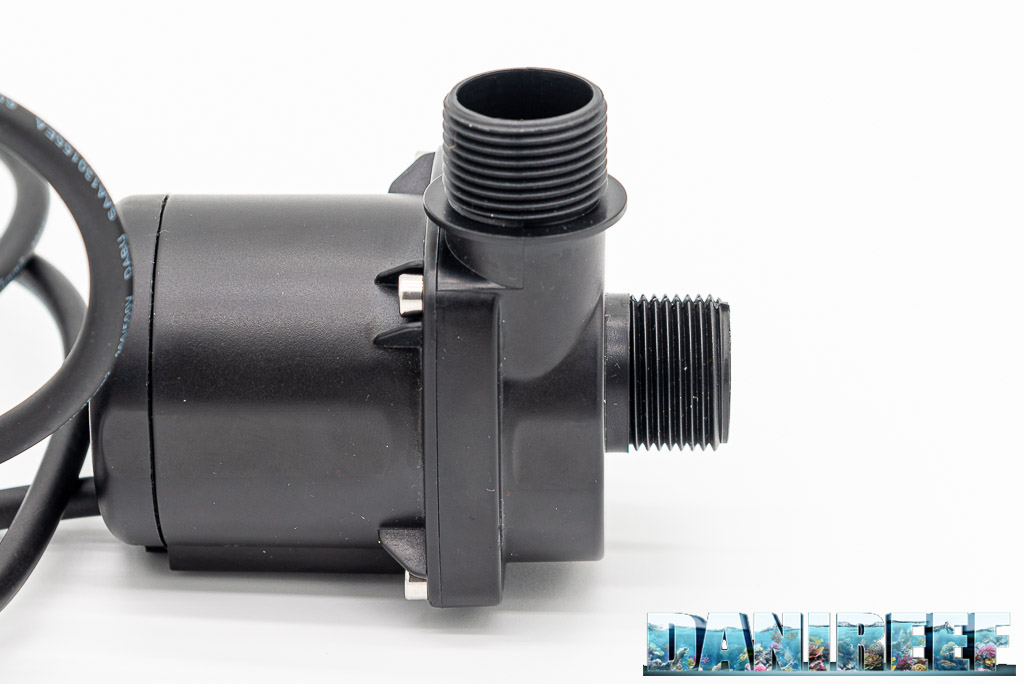
The ASF NewJet DC 2000 has a great declared energy efficiency: 93.5 liters for each consumed watt and an economic efficiency of 21.7 liters per second per euro, that’s a reference value of 3,118 l*m/h.
The price is relatively low for this kind of pump, you can purchase a very solid and safe product given the functioning at low voltage, ability to dim 12 steps, and great basic features. The energy efficiency is pretty good, and the retail price is average. Let’s see what we discovered in our lab and how the results fit into the set of values of other pumps that we have previously tested.
The construction
The pump is simple: it has the classic cylinder shape. It comes in black and grey, with fuchsia details that we like very much. The impeller shell, as you can see from the pictures, screws to the body with 4 stainless steel Allen screws.

Inside the package there are two couples of rubber holders of different size. You can choose the right one based on the diameter of your own return pump. Please remember, NEVER USE the smaller rubber holder. Read this article for the reason: How to save electric power in marine aquarium: the return pipe.
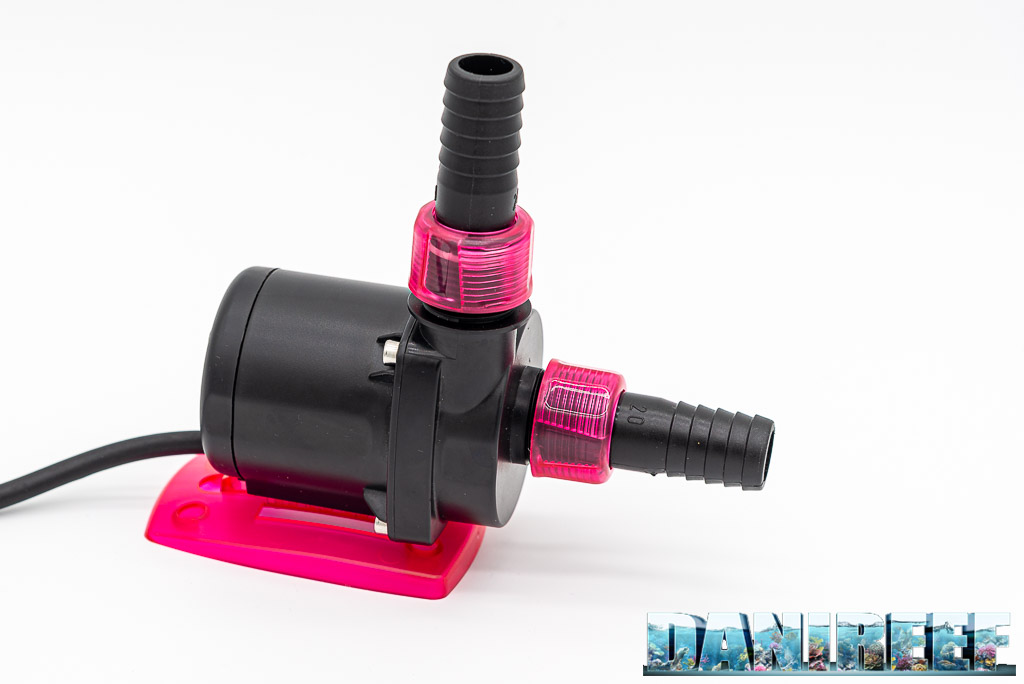

The impeller is the latest model with 6 curve blades, which is different than the previous similar pumps with a similar rate. In this way the pump is way more efficient.
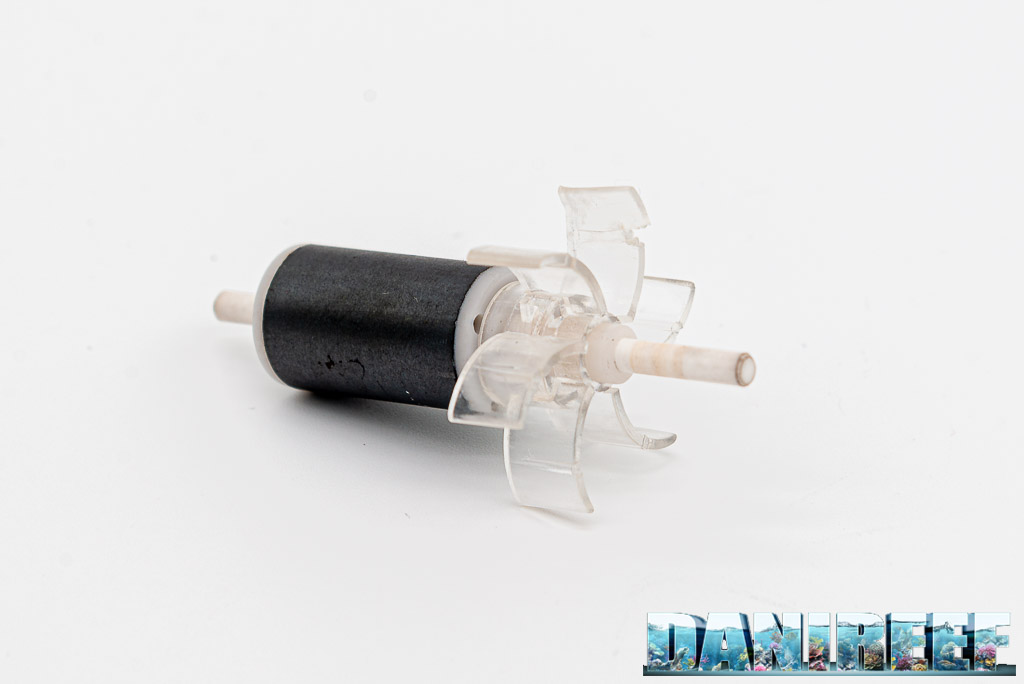
How to control the ASF NewJet DC 2000
The main characteristic of this pump is that its flow rate has 12 power steps. This means that through the integrated controller we have the option to set the flow rate (and the head) on 12 couples of values by lowering the engine revs (remember that they’re 24 V). Moreover, there’s a button to freeze the pump for 5 minutes. The flow rate of the pump is displayed on the 6 red LEDs that you find next to the buttons.
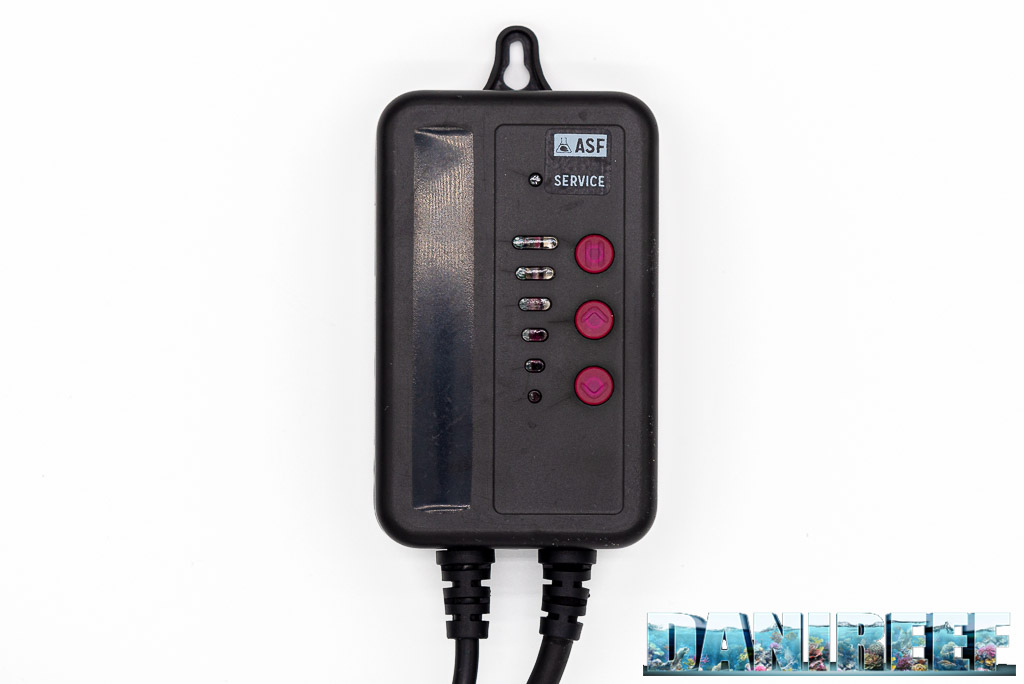
The pump is connected to the to the controller and the power through a couple of cords.
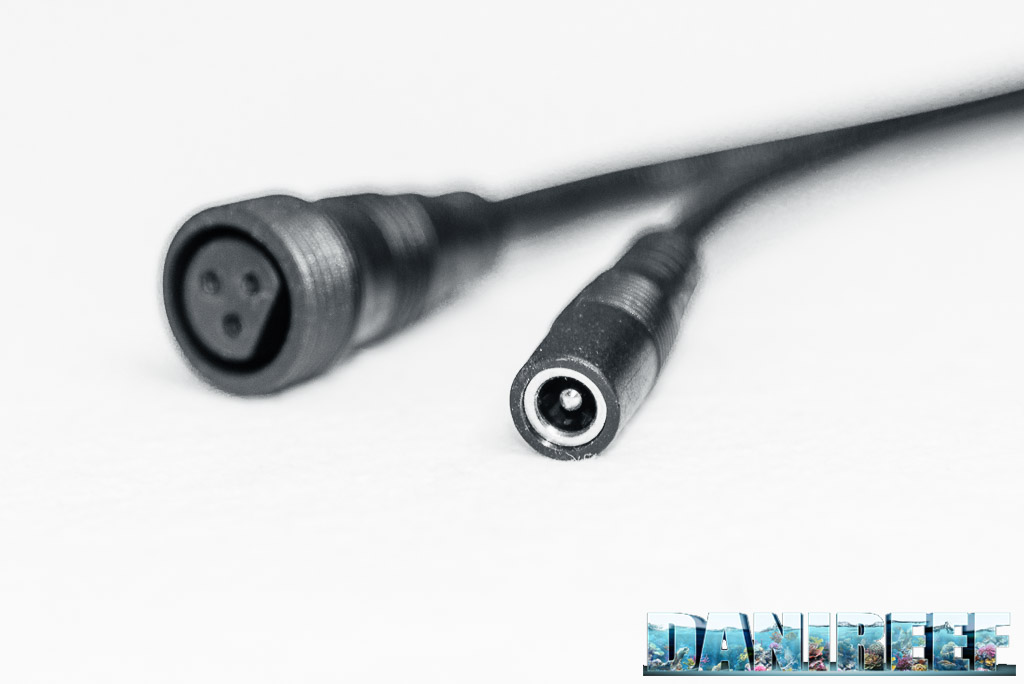
This small power supply cable comes with the Italian plug, capable of handling 48 watts, so extremely oversized for the load it has to bear.
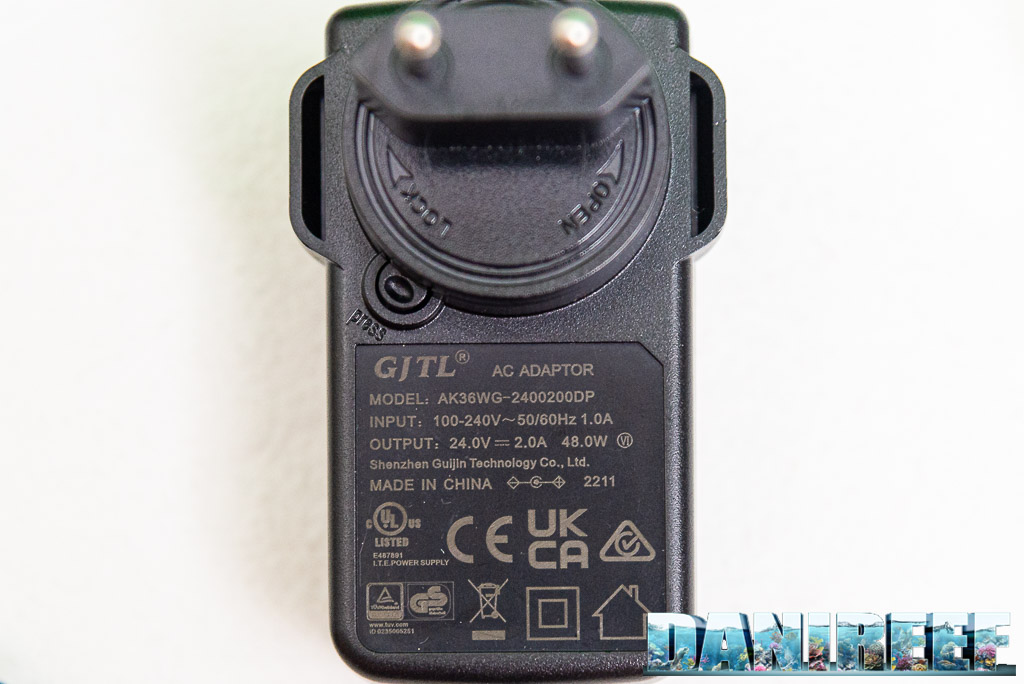
Hydraulic head test
The first test we did was the hydraulic head. You already know that that is the pump’s ability to elevate the water over a certain height. In order to this, we measured the level reached by the water inside a hose.
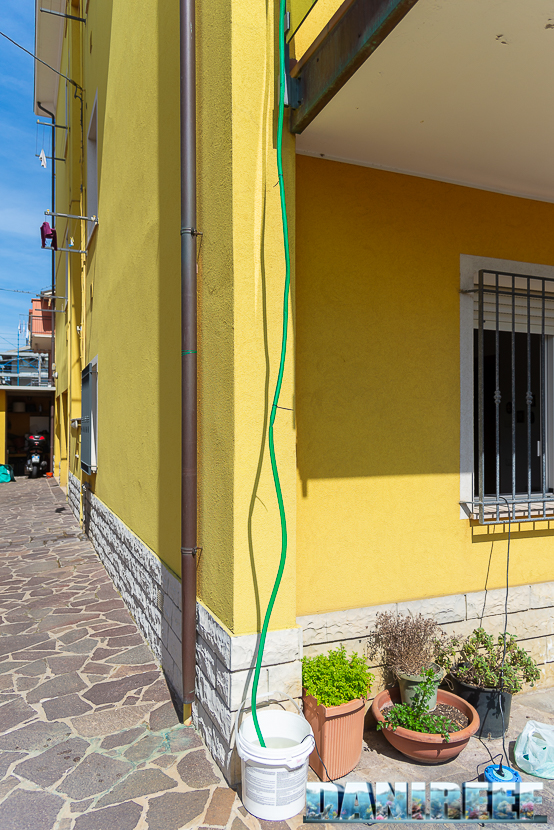
As you can see in this picture from our archive, we fix the hose to the terrace, we turn on the pump we intend to test, we wait about 10 minutes to let it stabilize, then we measure the head. Then we repeat the procedure for each power step. In the video above, you can see an abstract of this working method. Below is the chart that we extrapolated from the data we measured.
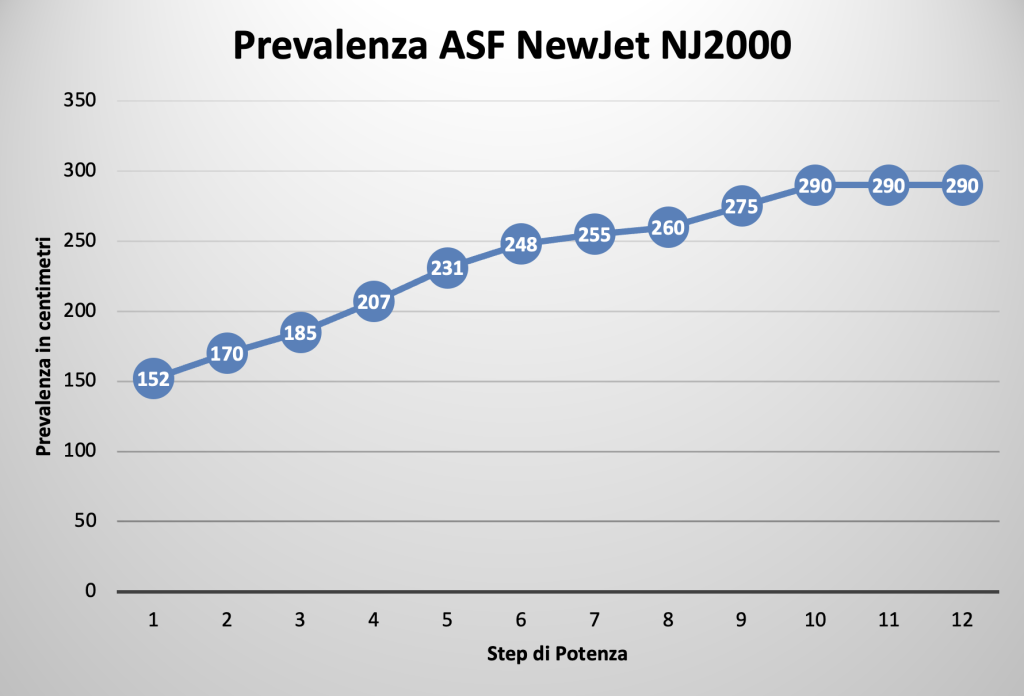
The head starts at 152 cm and goes up to 290 cm which the pump maintains for 3 steps. The maximum head declared is 290 cm, so the values are on point. So nothing to add, bravo Aquarium Systems!
Rate test
Measuring the rate was very easy thanks to the DigiSavant DIGIFLOW 6710M flow rate meter. First of all, we connected the hoses to our flow rate meter. We tried to make the device adhere perfectly to the pump’s outlet. In the video above, we explained the procedure.
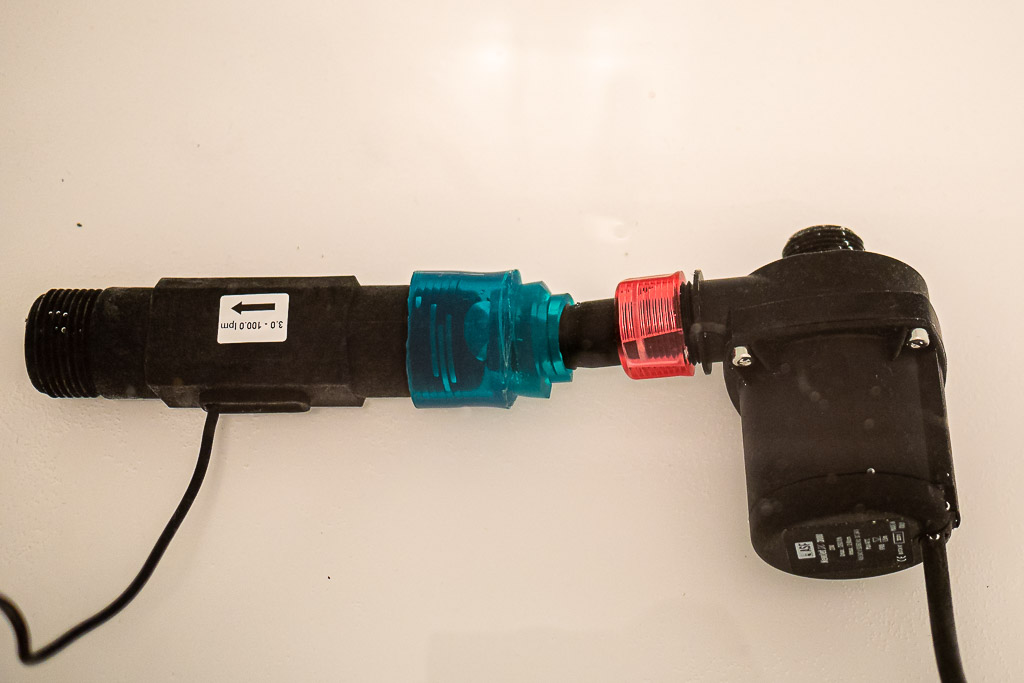
The measurement is expressed in liters per minute. So we only have to multiply the result by 60 to obtain the liters per hour.
Obviously, remember that the measure is valid within the conditions in which we did the test. The hose as we used it could have led to some discrepancy.
But our system resulted in this value:
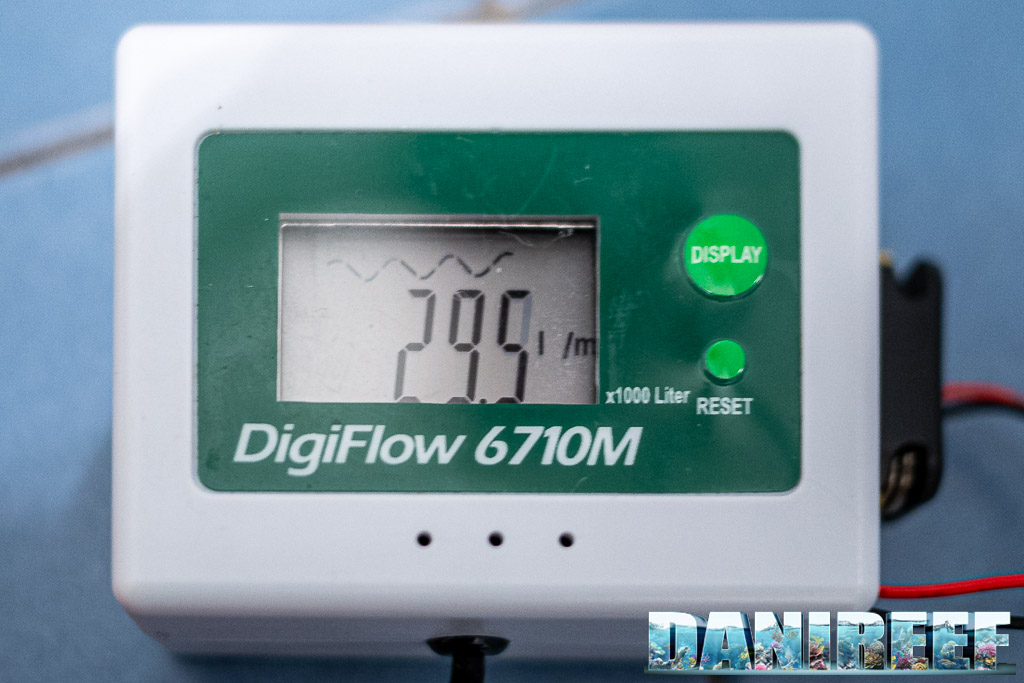
Numbers that, translated to liters per hours, considering all the 12 available steps, lead to the following chart:
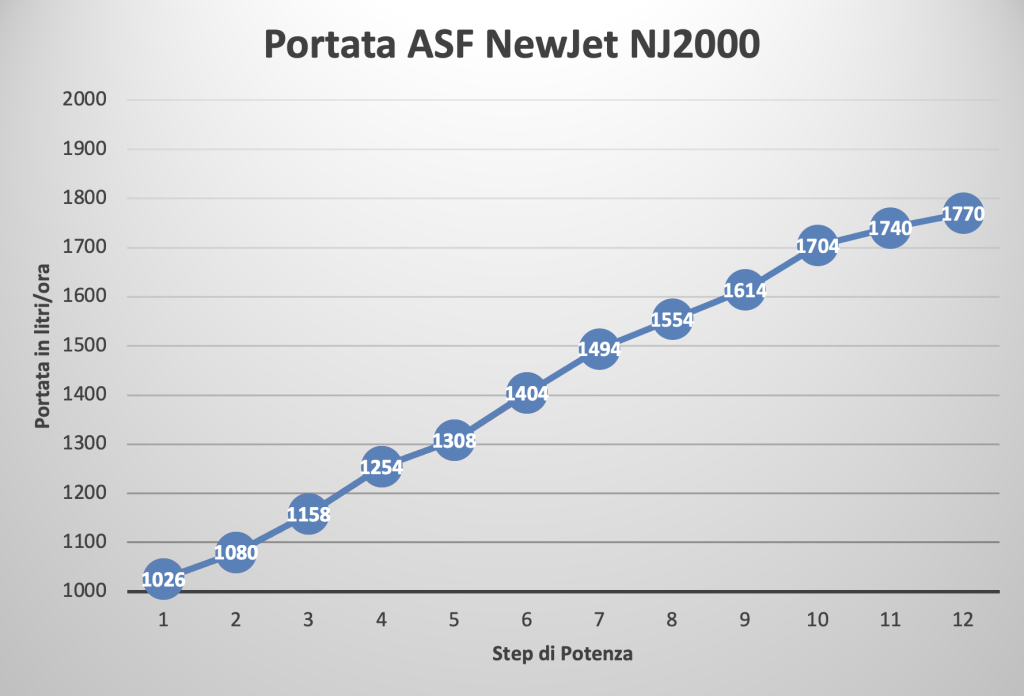
The maximum flow rate is 1,770 l/h (that is 29.5 l/m*60), slightly under the declared 2,150 l/h. So, the pump reached 82.3% of the declared value in our test conditions. A great value, among the best ever tested for a centrifugal variable flow rate pump. An excellent result if you consider the 66% of the Ecotech Marine Vectra M1 (article), the 67% of the Waveline DC6000 (article), the 70% of the Hydor Seltz D6000 (article), the 86% of the Rossmont RX 3200 (article) and the 82.6% of the Rossmont RX 5000 (article), just to mention some of the pumps that we have tested. And remember that we tested some pumps that had a flow rate under 50% of what was declared…
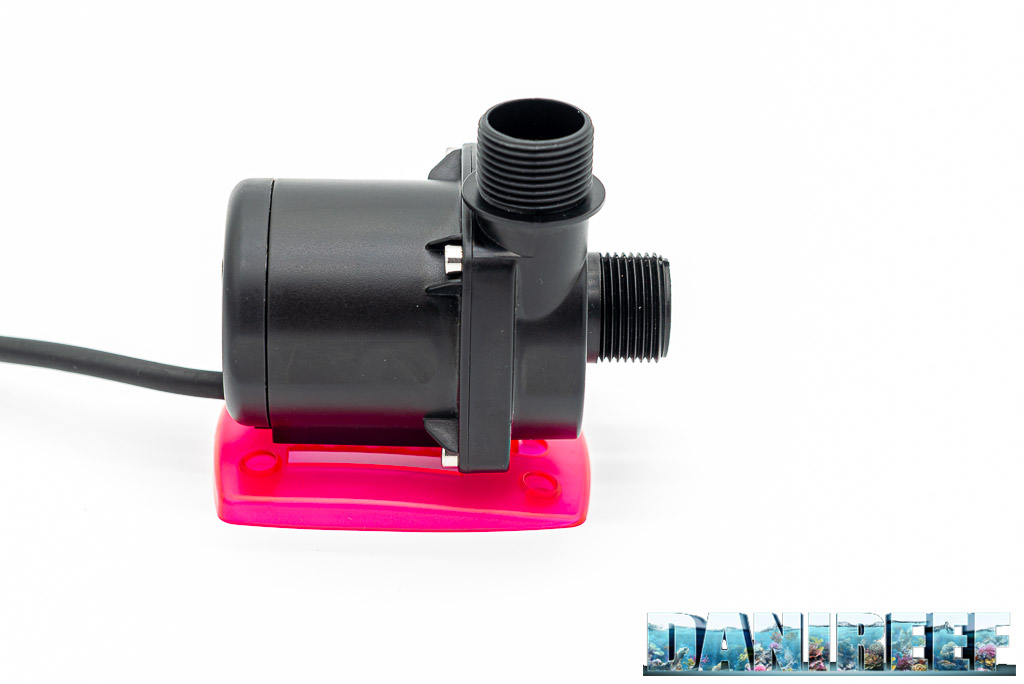
When you have to use a return pump be careful of the issues that can lower, sometimes sharply, the flow rate. Use the bigger rubber holder that is supplied. Always use a sufficiently wide pipe. The pipe has to be as short as possible and should have as few 90 degree elbows as possible. Otherwise the flow rate will be greatly penalized.
Power consumption test
The measurement of the power consumption was possible thanks to the useful RCE PM600, which can also measure the Cos(fi) (or power factor). The result is given in watts.
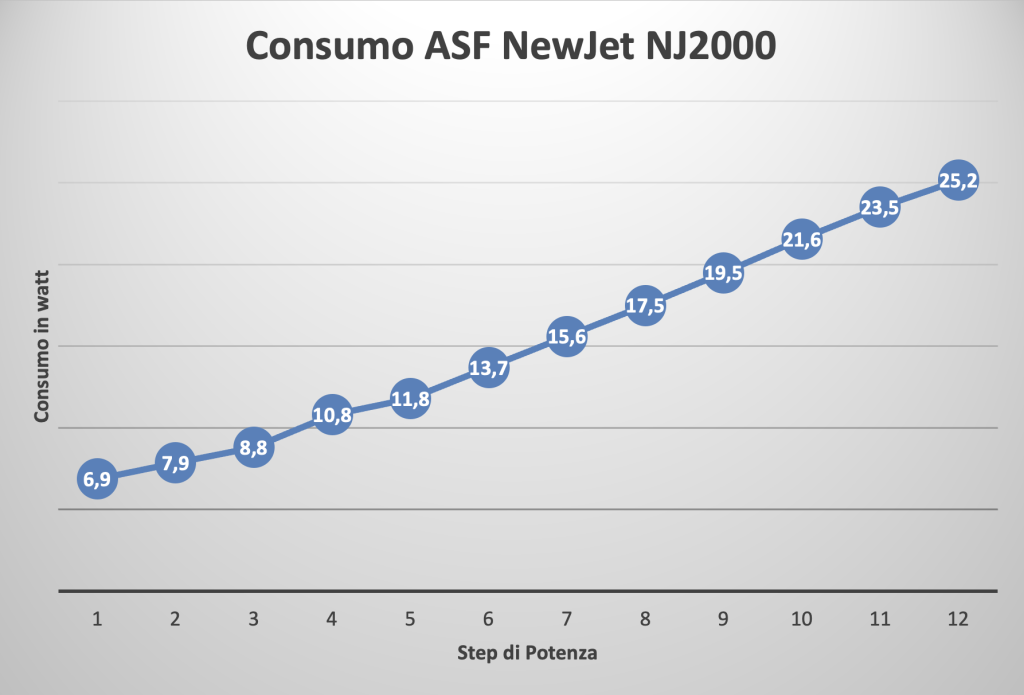
The maximum power consumption of the NewJet DC 2000 is 23 watts, and according to our measurements the maximum is about 25.2 watt, practically 9,5% more than the declared. Even in this case we can say that the values are pretty much the same.
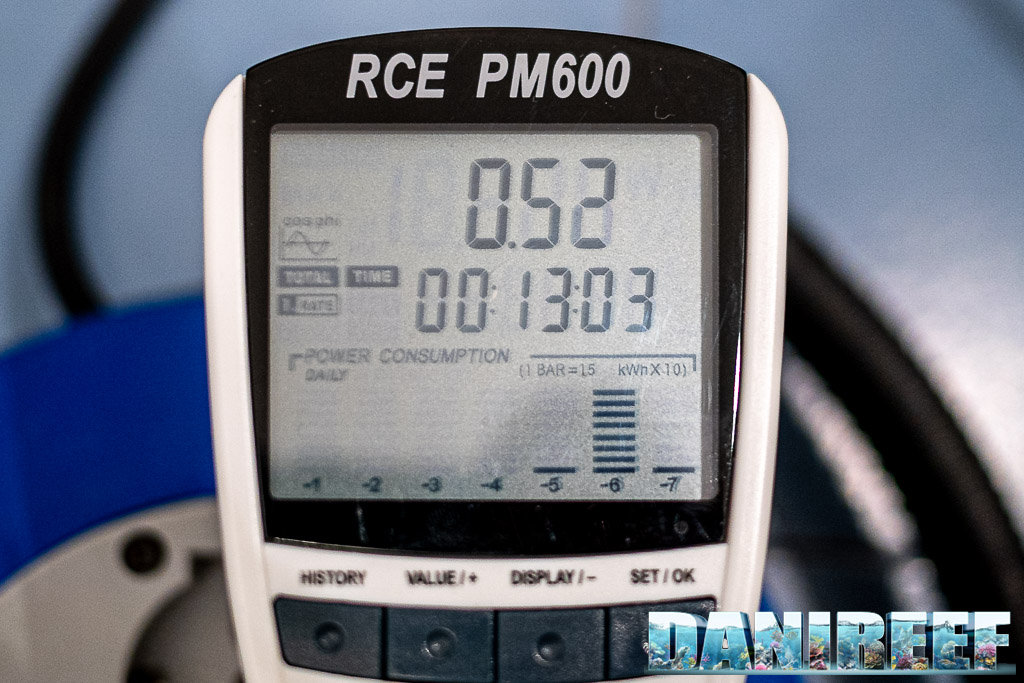
The Cos(fi) measured, which is the power factor, shows a value of 0.52, and practically speaking this means that this pump heats up a lot. Every pumps does that, this ASF is not unusual.
Considering a consumptions of 25.2 watts, and an energy cost of 0.27 euro/kwh, we could use this pump continuously for a whole year at its maximum with a power consumption of about 221 kwh, from which derives a cost of 59.6 euro per year, or 6 euro per month. Which is absolutely insignificant.
Given the size of the pump and, especially, its head value, we couldn’t do our usual noise test.

For lowering the noise there are 4 small soft rubber suckers included that go into the sleigh that in turn goes under the body of the pump. It has the double purpose of reducing both vibration and noise.
Our opinion
We heard great comments from our friends about this pump and our expectations weren’t let down. The pump is perfect and keeps its promises, and this detail is very rare, because the results of our practical tests often don’t match the declared data. But not in this case.

These conclusions will be substantiated by comparing them with similar pumps we have tested before!
Comparison with other pumps
The comparison with the other pumps we’ve tested is very interesting. In particular, we’re comparing the data from Eheim, Hydor, Tunze, Sicce, Corallinea, Waveline and Ecotech Marine; all are shown below in the chart.
We organized the chart based on the reference value of the pump, which is the product of the flow rate times the head divided by 2. In this way we obtain the subtended area. We believe this is the only way to compare homologous pumps. If the reference value differs too much we feel that they can’t be compared.
| Pump | Hydraulic head | Flow rate | Reference value | Power consumption | Price | Efficiency | Economic efficiency | Annual cost |
| Eheim 1250 | 195 cm | 1205 l/h | 1175 | 23.8 w | 98 € | 50.6 l/h*w | 12.3 l/h*€ | 56 € |
| Newa Jet 1700 | 200 cm | 1638 l/h | 1638 | 31.2 w | 43 € | 52.5 l/h*w | 38 l/h*€ | 74 € |
| ASF NewJet DC 2000 | 290 cm | 1770 l/h | 2566 | 25.2 w | 99 € | 70.2 l/h*w | 17.9 l/h*€ | 60 € |
| Sicce Syncra 3 | 296 cm | 2375 l/h | 3515 | 42.3 w | 100 € | 56.1 l/h*w | 23.7 l/h*€ | 100 € |
| Rossmont Riser RX 3200 | 281 cm | 2766 l/h | 3886 | 53.7 w | 115 € | 51.5 l/h*w | 24 l/h*€ | 127 € |
| Eheim 1260 | 350 cm | 2434 l/h | 4260 | 62.1 w | 155 € | 32.2 l/h*w | 15.7 l/h*€ | 147 € |
| Tunze 1073.50 | 436 cm | 2143 l/h | 4672 | 38.8 w | 180 € | 55.2 l/h*w | 11.9 l/h*€ | 92 € |
| Sicce Syncra 4 | 380 cm | 3709 l/h | 7047 | 94 w | 160 € | 39.5 l/h*w | 23.2 l/h*€ | 222 € |
| Corallinea BQ5000 | 404 cm | 3504 l/h | 7078 | 83.2 w | 120 € | 42.1 l/h*w | 29.2 l/h*€ | 197 € |
| Rossmont Riser RX 5000 | 364 cm | 4128 l/h | 7513 | 83.7 w | 145 € | 49.3 l/h*w | 28.5 l/h*€ | 198 € |
| Waveline DC6000 | 392 cm | 4008 l/h | 7857 | 50.2 w | 283 € | 79.7 l/h*w | 14.1 l/h*€ | 119 € |
| Hydor Seltz D6000 | 450 cm | 4194 l/h | 9437 | 53 w | 125 € | 79.1 l/h*w | 33.5 l/h*€ | 125 € |
| Ecotech Marine Vectra M1 | 610 cm | 4944 l/h | 15080 | 89.5 w | 399 € | 55.1 l/h*w | 12.3 l/h*€ | 212 € |
You can see from the chart that economically speaking, the ASF is in the average of the most convenient pumps. For the technical efficiency, considering only the maximum values, the NewJet DC 2000 is among the best performers. Only the Waveline DC6000 and the Hydor Seltz D6000 are more efficient, but they also have very different flow rates so they can’t be easily compared. So if the couple of values that you need match, or at least are similar to this pump now you don’t have any excuse! Moreover, it’s an adjustable pump – what more do you want?
The relationship with the declared data
Now let’s see the relationship to the data declared by the manufacturer.
Hydraulic head
| pump | hydraulic head | Measure | Gap |
| ASF New Jet DC 2000 | 290 cm | 290 cm | 0 % |
The measure of the head is the same as declared. The ASF keeps its promise.
Flow rate
| pump | hydraulic head | Lab measure | Gap |
| ASF New Jet DC 2000 | 2,150 l/h | 1,770 l/h | – 18 % |
The gap between measured and declared rate is close to 18%, and very few times have we seen a pump measure so close to the declared data. Chapeau! Often the gap is up to 40%.
Power consumption
| pump | Power consumption | Lab measure | Gap |
| ASF New Jet DC 2000 | 23 w | 25.2 w | + 9,5 % |
The power consumption is higher than 10%, more or less. Considering the conditions of the test, I’d say that’s another value in line with what is declared.
Closeness to the declared data
Finally we can assign a value to the correspondence with the data declared by the manufacturer for rate, head, and consumption.
| pump | Hydraulic head | Flow rate | Consumption | Final Value (absolute value) |
| ASF New Jet DC 2000 | 100 % | 82% | 90.5 % | 90,8 % |
If you want to know if this pump suits your needs, based on the head that you have in your aquarium, I suggest you check out these articles:
The latter will show you the estimated flow rate based on your own conditions.
Why the declared and measured value of the flow rate never match
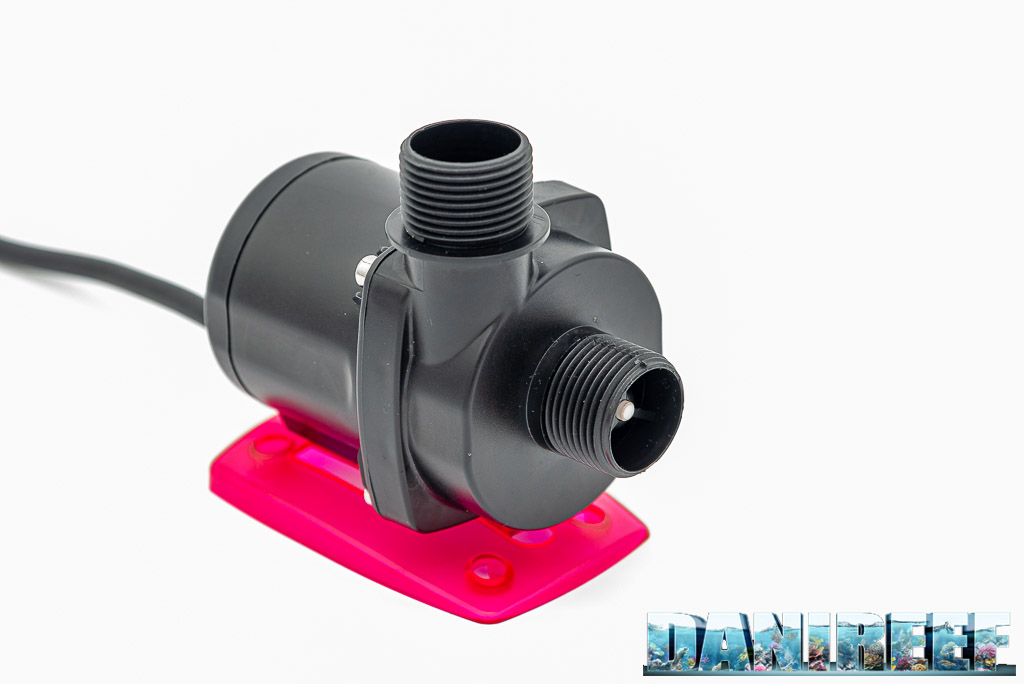
You may ask why we always underline that the rate performance of a pump doesn’t match the declared values. In laboratory conditions, such as the ones that companies use for testing their own pumps, you are in the perfect ideal condition, which is pretty different from the real one. Usually, you use a meter directly keyed to the outlet of the pump, thus avoiding chokes, load pressure drops, and friction. A series of things that obviously happen in real life, therefore in our test. And this leads to a difference that can be incredibly significant with pumps with a high flow rate. So, if you take a pump of 5,000 l/h consider that, if you are lucky, they will be about 4,000, and there are also the problems listed before and that you find discussed in the links above.
Conclusions
The reference value of the NewJet DC 2000 is 2,566 l*m/h, while the declared reference value is 3,118, a small gap of 18%. Remember that the reference value is the area subtended by the values of head and rate. The calculation is (head x rate)/2.
The loss 18% actually represents a very great value given the fact that the other competitors do worse.
In order to use a pump in our aquarium we always have to consider what it actually expresses, and not what it should. But in this case the values are practically identical. An incredible result that can be decisive for your choice.

PROS
 Great performance and true to the declared data compared to the category
Great performance and true to the declared data compared to the category Very well built
Very well built Silent
Silent Modulable on 12 steps
Modulable on 12 steps
CONS
 Nothing to report!
Nothing to report!

Disclaimer: Thanks to Aquarium Systems for providing us with the ASF NewJet DC 2000 pump for this review.










0 Comments